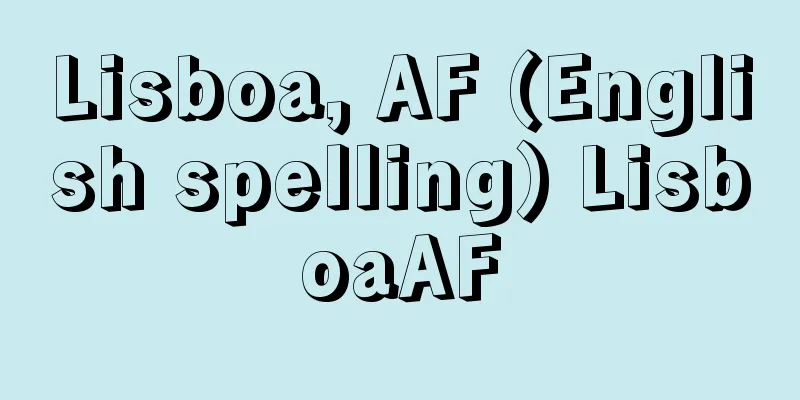Spanish Theatre

|
Because Spaniards see life as a drama, there is a strong dramatic element in bullfights, religious ceremonies, and political rallies, so it can be said that theater has always played an important role in Spanish culture. [Makiho Nonoyama] historyThe oldest forms of theatre in Spanish are medieval religious dramas, but at the same time there were also popular farces (farces). The oldest surviving work today is the Eucharist Play of the Three Wise Men from the early 13th century. After a gap of about three centuries, at the beginning of the 16th century, under the influence of medieval theatre and the Renaissance, Juan del Encina (1468?-1529?), who is said to be the founder of Spanish theatre, appeared and wrote pastoral plays and other works. Next, Torres Naharo studied Aristotle's poetics, established his own playwriting techniques, and put them into practice in his own works. Around the same time, Gil Vicente (1465-1537?) built the foundations of Portuguese theatre, which also had an influence on Spain. In the mid-16th century, Lope de Rueda, influenced by Italian theater, created the "paso," a one-act prose skit about the everyday life of the common people, bringing theater closer to the common people. Miguel de Cervantes's interludes "entremés" in the 17th century and his "sainete," a verse comedy of the 18th century, followed this trend. From the late 16th century to the 17th century, Spain experienced the height of its theatrical glory, known as the "Golden Age" (siglo de oro), which rivaled Elizabethan English theater. The leading playwright of this period was Lope de Vega (1562-1635), who ignored the rules of tragedy and comedy and created the great national theater, the "commedia," which captured the hearts of people of all classes. The main theme of his plays was honor, and the main genre was the "coat and sword play" (commedia de capa y espada), in which a nobleman chases the woman he loves and overcomes various obstacles to be united with her. He also wrote a huge number of other works, including national history plays and sacramental mystic plays. Around this time, the construction of theaters in and around Madrid also contributed to the development of Spanish theater. These permanent theaters, called corrals, had a semicircular stage facing a courtyard (patio), with men's chairs at the front, women's chairs lined up in a gallery (galeria), standing seats at the back, and seats for the nobility behind the windows of the buildings on either side. The stage set was simplified, and actors would clarify the location in their lines, saying things like "in this palace" or "in the woods." Performances generally lasted three hours, starting at 3pm in the summer and 2pm in the winter. Besides Lope de Vega, other major playwrights who graced the Golden Age were Tirso de Molina, who created the prototype of Don Juan in The Seville Playboy and the Stone Guest (1630), Luis de Alarcón, who created unique character plays focusing on the personalities of the characters and the customs of the time, and Calderón de la Barca, who tackled philosophical and theological themes such as freedom of will and wrote plays such as La vie d'état (1635) and The Mayor of Salamea (1636). An interesting feature of the Golden Age stage was the absence of mothers, with fathers and brothers playing key roles in protecting the chastity of their daughters and wives. The 18th century was a period of imitation of classical French drama, as represented by Fernández de Moratín, and did not produce any noteworthy playwrights, although Cruz's "Sainete" was very popular. The 19th century was the age of Romanticism, marked by the works of Zorrilla, author of Don Juan Tenorio (1844), and Marques de Rivas, author of Don Álvaro, or the Forces of Destiny (1835). In the latter half of the century, Tamayo y Baus and Echegaray, as well as the brothers Benavente and Álvarez Quintero, each produced masterful works that enlivened the theaters of the Belle Époque. [Makiho Nonoyama] present dayFrom the early 20th century to the Spanish Civil WarIn the 20th century, Etchegaray and Benavente received the Nobel Prize in Literature, but it was Unamuno, Valle-Inclán and García Lorca who had a profound influence on modern theater. Unamuno eliminated all decoration and depicted raw confrontations between egos, while Valle-Inclán created esperpento (nonsense theater), inspired by the deformed images of concave mirrors, in order to destroy traditional values. García Lorca, meanwhile, revived national traditions with a modern sensibility and was recognized worldwide for his three great national tragedies: Blood Wedding (1933), Hierma (1934) and The House of Bernarda Alba (1936). However, during the Spanish Civil War (1936-39), Lorca was shot, and writers such as Alberti, Grau and Casona fled to South America. [Makiho Nonoyama] After the Civil War until the 1970sAfter the civil war, the Spanish theater scene was restarted with the socialist Buero Vallejo's The Story of a Staircase (1949). It portrayed the dreams of people living in cheap apartments who are thwarted in the struggle for survival, and struck a chord with audiences who still bore the scars of the civil war. Sastre then produced Platoon of Death (1953), an existentialist political play that questions who is responsible for a murder that takes place in a closed house. The two continued to produce many works, building the foundations of Spanish theater after the civil war. From the 1960s to the 1970s, a kind of avant-garde theater called "nuevo teatro" (new theater) was born, which was different from the realist theater of Buero Vallejo and Sastre. Its representative playwrights were Ruibal, Francisco Nieva (1927-), and José Luis Matilla (1939-), who all rejected psychological description, moved away from everyday life, and incorporated many elements of fantasy, allegory, and surrealism. The themes they deal with, such as social injustice, exploitation, class struggle, and distortions of instincts and emotions, are universal contemporary issues that transcend national borders, and the traditions of Garcia Lorca and Valle-Inclán are beautifully alive in them. Madrid has two national theaters: the Maria Guerrero Theater and the National Drama Center. Since democratization, any type of theater has been able to be performed here, but since the public does not like avant-garde theater, melodramas are often performed here. [Makiho Nonoyama] 1980s and afterThe characteristics of Spanish contemporary drama since the 1980s include a renewed realism, a fusion of fiction and the author's private life and feelings, and a depiction of the social environment. Furthermore, a new phenomenon was seen in which directors, aiming to attract audiences, tried to make the stage more dramatic by using techniques far removed from the script. This phenomenon is also related to the fact that actors found opportunities for self-expression in events such as the opening ceremony of the Olympic Games and the Seville Universal Exposition. The fusion of literature and show business became commonplace. Playwrights also began to write serial TV dramas, which began to compete with football in TV ratings. Josep Maria Benet i Jornet (1940- ), Sergi Belbel (1963- ), and Antonio Onetti (1962- ) were commercially successful playwrights as well as screenwriters. A famous avant-garde theatre company, some of its members were persecuted and imprisoned by the government in the 1970s for their satire of the military, while the pantomime troupe Els Joglars captivated television audiences with their parody of hasty modernisation, We Are European Now. Since 1999, the Barcelona theater company Focus has been working hard to maintain the quality of its theatrical productions while also achieving commercial success, and has achieved an increase in audience numbers of 1.5 million between 1998 and 1999. A similar movement has been seen in Madrid, led by actor Rafael Alvarez. Madrid and Barcelona monopolize 40% of the approximately 12 million annual audience, but Barcelona stages roughly twice as many plays as Madrid. One thing that made it easier for new playwrights to emerge was the Marquis de Bradomin Prize (named after a character in the work of the writer Valle-Inclán), which was established by the Youth Association in 1985 for playwrights under the age of 30. This made Catalan playwright Sergi Bellber famous. In the 1990s, the Socialist Workers' Party actively provided financial support to the theater world through the Ministry of Culture. As the head of the National Drama Center, it appointed the internationally renowned director Lluís Pasqual (1951- ), who led the Spanish theater world from 1989 to 1996. However, there was criticism that the government's involvement pushed small theater companies with high literary value into the margins. Although some criticized the direction of Tejedas Feldman, who used music and video to enhance the illusion and aim for a hypnotic effect on the audience, he brought new elements to the stage and attracted attention. Meanwhile, avant-garde theater companies that emerged in the 1960s continued to exist in the provinces even after the 1990s. Among them, La Cuadra of Seville introduced flamenco and had a great success in Madrid with its Andalusian interpretation of Greek mythology. Also not to be overlooked is the emergence of female playwrights who made feminism their selling point, such as Lourdes Ortiz (1943-), María Manuela Reina, and Paloma Pedrero (1957-). In the 1980s, there was a strong tendency to be conscious of the stage, and the audience's request was "no message, just dramatic plays," but the trend changed in the 1990s. Antonio Álamo (1964- ) depicted a meeting between Stalin, Churchill, and Hitler in The Sick (1997), which exposed the cynical hypocrisy of power and interests, and Onetti depicted a meeting of scientists responsible for the atomic bomb in Drunkards (1988), making theater a place to convey ideological messages. The leading role in the theater world shifted from directors and theater companies to playwrights, and theater again became closer to novels. However, the constant effort to innovate stage effects continued. For example, Rodrigo Garcia's (1964- ) play Prometeo (1996), about the identity of a boxer, successfully garnered attention by using a technique in which lyrical poetry is recited by four voices. From the end of the 1980s to the 1990s, Spanish theatre began to take up the same themes as those in postmodern European theatre: everyday problems faced by the marginalised classes of young people in big cities, drugs, violence, sex, etc. Short dialogues, rapid scene changes, and the passionate, dynamic conversations that are unique to big cities. Ideological and political criticism is hidden in these, but what is important is that they have become a motif for aesthetic creation. In this trend, Ernesto Caballero (1957-) and Antonio Onetti gave traditional realism a modern twist, opening up new territory. Francisco Nieva, who was active as a director and set designer, also moved from theater to playwriting, and won the National Theater Award and the Prince of Asturias Award in 1992 for his imaginative absurdist play Dance of the Passionate People (1990). He placed importance on freedom of expression and attempted an open theater that allowed directors and actors to make free comments. During the Franco era, Buero Vallejo's La Fundación (The Institution), which breathed fresh air into the theater world, was the work that attracted the most attention in 1998. Sastre retired from the theater world after producing The Great Bar (1985) and The Last Days of Emanuel Kant (1990), but continues to send out politically challenging messages in the Basque Country. Fermín Cabal (1948- ) was successful in publishing, and started out with the drug-themed The Devil's Horse (1990), and in 1992 he portrayed the political corruption of the Socialist Workers' Party with Mischief. Ernesto Caballero depicted social dark zones in While I Was Watched (1995), and attempted to have a direct dialogue with the people, especially young people. As we enter the 21st century, Spanish audiences are likely to demand "emotional and human drama," and performers will likely seek to integrate the trends of the 1980s and 1990s. The diversity of techniques that has been developed gives performers a wide range of possibilities and confidence, and the future of Spanish theater looks bright. [Makiho Nonoyama] Contemporary Latin American TheatreOriginModern theater in Spanish-speaking Latin American countries began with old-fashioned romantic works imitating Etchegaray, set in Buenos Aires, Argentina. In the 1930s, the center of theater shifted to Mexico, where Rodolfo Usigli (1905-79) and José Gorostiza (1901-73), who raised social issues, were active. In the 1940s, avant-garde experimental theater was born in Mexico, with Calbalido and Carlos Solózano (1922- ) as leaders. After that, playwrights influenced by Brecht, Beckett, Osborne and others emerged in each country. Among them are Chilean Egon Wolf, author of The Intruder (1977), and Puerto Rican René Marqués (1919-79), author of The Crescent Moon (1958), who wrote excellent psychological dramas set against political and social backgrounds. [Makiho Nonoyama] Features and developmentA distinctive feature of contemporary Latin American theater is its commitment to social and political change. In this respect it differs from North American and European theater, and its writers uniformly take a militant stance. In a 1980 feature on contemporary Latin American drama in the Brazilian magazine Teatro, the Brazilian playwright Augusto Boal (1931- ) and the Colombian playwright Enrique Buenaventura (1924- ) made it clear that they were following Brecht's lead. Buenaventura stated that their mission was to open the audience's eyes to the fundamental problems of the country in order to change society. Their target was to win over the broad middle class. Boal's São Paulo theater company, Arena, was the most important group in Brazil, and continued to introduce Brecht's plays until he was imprisoned in 1971. After that, Boal traveled in exile to Argentina, Peru, Portugal, and France, where he tried new experiments such as the newspaper theater, the invisible theater, and the trial theater. He combined Brecht's theater theory with the educational theory of Brazilian educator Pouro Freire (1921-97), rejecting the classical theater theory that had existed since Aristotle. After the fall of the military regime, Boal moved to Brazil and opened workshops in Rio de Janeiro and São Paulo. In the 1970s and 1980s, Latin American playwrights were violently persecuted by the governments of their countries. For example, the Picadero Theater in Buenos Aires, which had just begun new experiments such as open theater, was closed in 1981. Censorship in Latin America was generally severe, as Latin American politicians were concerned about the effectiveness of theater, focusing on its role in raising the political consciousness of the masses. This approach was modeled on the dictators of Spain and Portugal. Major theaters in Buenos Aires, Santiago, Montevideo, Rio de Janeiro, and São Paulo were closed many times by the authorities of the time. On the other hand, Latin American writers who used the technique of absurd theater, unlike their North American and European counterparts, all tried their hand at creating plays with violence as a theme. French theater of cruelty was transformed into theater of violence, and the theme of violence was expressed in written language or physical violence in order to appeal strongly to the audience. Theater of cruelty was created by the French actor and director Antonin Artaud, and it placed more importance on gestures than dialogue, confronting the audience with the conditions that create social crises and encouraging them to think. The Colombian Navajas Cortes's La mort (1976) is a tragicomedy in which a landowner who, with the help of his wife, pretends to be dead to escape an uprising by angry peasants, falls into a trap he set himself and is buried alive. There are many plays that deal with the theme of torture. Based on the idea that the existence of torture should not be simply confirmed but understood, following the example of Spain's Sastre, Boal criticizes the system that gave birth to torture through psychological analysis of the victims. Brazil's Boal depicts the horror of torture using the 15th century Spanish Inquisitor Torquemada as the protagonist. In Pedro and the Captain (1962), Uruguay's Mario Benedetti vividly depicts Pedro's body gradually breaking down due to torture. However, plays that deal with the theme of torture but are not performed on stage have a stronger impact. Representative works include Mr. Galindez (1979) by Argentina's Eduardo Pavlovsky (1933-). Latin American theatre from the 1970s to the 1990s managed to combine creativity and artistry with social and political commitment. Whereas brutality is a metaphor for life in North America and Europe, in Latin America it is a concrete reality. Yet in these dramas the victims somehow find relief and a glimmer of hope remains. [Makiho Nonoyama] Cuban and Nicaraguan TheatreThe theatrical situations in Cuba under the Castro dictatorship and in Nicaragua, which was briefly under the Sandinista leftist government from 1984, are somewhat different from those in other countries, so they will be treated separately. Cuba and post-Sandinista Nicaragua created theatrical environments that allowed the voices of historically marginalized groups to be recorded. The Buendía Theatre Company, named after a character in García Márquez's One Hundred Years of Solitude, was founded in 1985. Its leader is the actress and playwright Flora Laurent, and all the actors are elite graduates of the École des Beaux-Arts. They performed Lila and the Butterfly (1954), a rewrite of the 1954 work Rolando Ferrer, which is a Cuban version of A Streetcar Named Desire. Lila is a dressmaker, but she is a corrupt woman and can no longer run her shop. She commits suicide at the end of the second act, and in the third act the audience participates in her funeral procession. They rewrote the play before the revolution to show young people the reality of a corrupt country under American influence and compare it with present-day Cuba. However, many theater people left Cuba, disappointed by the culture in which criticism of the revolution was not tolerated at all. The Ministry of Culture adopted a policy of mobilizing audiences, and the students at the École des Beaux-Arts were the elite, with only a dozen or so students. The government worked hard to strengthen the Buendía Theater, but the centralization of Cuban theater meant that the theater world became stagnant. Meanwhile, young playwrights born fifty years after the revolution were amateurs, and a movement to revitalize Havana began with them in the suburbs and mountain areas. For example, Venezuelan Victor Varela (1935-84) performed The Fourth Wall, which he called Obstacle Theater, in front of a small audience in his living room. In addition, individual groups made up of members of the Cuban National Dance Company created a street culture called plastic activities. The Ministry of Culture gradually began to accept such individual groups and provide financial support. The stage moved from theater buildings to various places such as the streets, and there are about 70 small groups in Havana alone that are seeking financial support from the government. A defining feature of culture during the Sandinista revolution in Nicaragua, which lasted for about ten years (1979-90), was the dismantling of centralization. Guerilla warfare took place in the mountainous regions, leaving the capital, Managua, uninvolved. This led to localization of military activities and the collapse of economic and political centralization. This phenomenon led to political devastation, but cultural flourishing. Initially, the Ministry of Culture tried to centralize culture, but the responsibility was transferred to the Sandinista federation, known as the Cultural Workers, who received a full-time salary from the government. However, due to budgetary constraints, the Ministry of Culture was dissolved by February 1988 and became a division of the Ministry of Education, and the Sandinista Cultural Association was formed independently of the government. The association also received foreign aid. In Nicaragua, the Pacific and Atlantic coasts are strongly influenced by Britain and the United States, but each region has its own unique culture. The Sandinista cultural policy was to drive out North American influences through a wide range of programs, including film, music, and television. However, this was not easy, and even if they were able to drive out North American influences temporarily, they soon returned. The experimental theater group Miguel de Cervantes performed plays incorporating Western pop music, breakdancing, and movies in movie theaters and high schools. Rural cultural productions are being produced on farms in the regions, but the lack of professional groups like those in Cuba is a problem. The theater group "Nix Tayolero" was created by Alan Bort in the 1970s and performed political agitation plays in various cities. Thirteen farmers from the Matagalpa farm and farmers from other regions participated, bringing in a variety of local cultures. In addition, the community theater group Teyo Koyani, which was active until 1988, performed Juan and His World, a two-act play that contrasted pre-revolution and post-revolutionary society, and was a great success. The third act was created by the audience, and it emphasized the tension between the center and the periphery, and called for a return to the center. After the Sandinista Revolution, the urban theater scene relied on directors from Mexico, Colombia, El Salvador, Argentina, and Spain, and lost its originality. The process of forming political culture in Cuba and Nicaragua is not simple. Theater in Nicaragua was born as a tool of revolution, but there are many questions that need to be answered, such as why it quickly shifted to criticizing the revolution, and why Cuba's theater world remained dependent on the state for so long after the revolution. [Makiho Nonoyama] "The Complete Works of Lorca" by Garcia Lorca, translated by Chonan Minoru, Obayashi Fumihiko, and others, 3 volumes (1992, Okisekisha) " ▽ "Selected Works of Spanish Medieval and Golden Age Literature 7: Masterpieces of Baroque Theatre" by Calderon de la Barca, Lope de Vega, and Tirso de Molina, translated by Satake Kenichi and Iwane Kunikazu (1994, Kokusho Kankokai)" ▽ "Selected Works of Contemporary Spanish Theatre - Attempts at New Spanish Theatre in the Age of Franco" by Miguel Miura, Antonio Buero Vallejo, and Alfonso Sastre, edited and translated by Satake Kenichi (1994, Suiseisha)" ▽ "Popular Theatre in the Spanish Golden Age" by Satake Kenichi (2001, Sanseido)" ▽ "History of Spanish Theater" by Charles V. Aubrun, translated by Aida Yu, Tobari Tomoo, and Tobari Noriko (Hakusuisha, Que sais-je)" ▽ "Albuquerque Severino JoãoA Study of Contemporary Latin American Theatre (1991, Wayne State University Press)" ▽ "George Yúdice, Jean Franco, and Juan Flores, editorsOn Edge: The Crisis of Contemporary Latin American Culture (1992, University of Minnesota Press)" [References] | | | | | | | | | | | | | | | | | | | | | | | | | | | | | | |Source: Shogakukan Encyclopedia Nipponica About Encyclopedia Nipponica Information | Legend |
|
スペイン人は人生を一編のドラマと考えるために、闘牛、宗教的行事、政治集会においても劇的要素が濃厚にみられる。したがって演劇は、スペイン文化においてつねに重要な役割を果たしてきたといえよう。 [野々山真輝帆] 歴史スペイン語のもっとも古い演劇は、中世の宗教劇であるが、同時に庶民的な笑劇(ファルス)なども存在した。今日残っている最古の作品は、13世紀初めの『東方の三博士の聖餐(せいさん)劇』である。およそ3世紀にわたる空白の時代を経て16世紀の初め、中世演劇とルネサンスの影響のもとに、スペイン演劇の創始者といわれるエンシーナJuan del Encina(1468?―1529?)が現れ、牧歌劇などを書いた。ついでトーレス・ナアーロがアリストテレスの詩学に学んで、劇作術を確立し、自作品のなかで実践した。同じころジル・ビセンテGil Vicente(1465―1537?)がポルトガル演劇の基礎を築き、スペインにも影響を与えた。 16世紀中葉には、イタリア演劇の影響を受けたロペ・デ・ルエダが、庶民の日常的なできごとをテーマに散文による一幕物の寸劇「パソ」pasoを創造し、演劇を庶民に近づけた。17世紀のミゲル・デ・セルバンテスの幕間劇「エントレメス」entremés、18世紀の韻文の笑劇「サイネーテ」saineteは、この流れをくんだものである。 16世紀後半から17世紀にかけて、スペインはエリザベス朝のイギリス演劇と並ぶ、「黄金世紀」シグロ・デ・オロsiglo de oroといわれる演劇の最盛期を迎えた。この時代の中心的劇作家はロペ・デ・ベガLope de Vega(1562―1635)で、悲劇・喜劇のルールを無視し、あらゆる階層の心をとらえる一大国民演劇「コメディア」comediaを創造した。そのおもなテーマは名誉であり、おもなジャンルは、貴族が恋する女性を追いかけ、さまざまな障害を乗り越えて結ばれるという筋書きの「合羽(かっぱ)と太刀(たち)の劇」コメディア・デ・カパ・イ・エスパダcomedia de capa y espadaである。ほかにも彼は国民史劇や聖餐神秘劇など膨大な数の作品を書いている。 このころ、マドリードの市内や郊外に劇場が建設されたこともスペイン演劇の発展に寄与した。コラールcorralとよばれるこの常設の劇場は、中庭(パティオ)に面した半円形の舞台が中心で、前面に男性用の椅子(いす)、回廊(ガレリア)に女性用の椅子が並び、後方にうるさ型の立見席があり、左右の建物の窓の奥に貴族の観覧席が設置された。舞台装置は簡略化され、俳優が「この宮殿で」とか「森の中で」とか、台詞(せりふ)のなかで場所を明らかにした。一般に上演時間は3時間で、夏は午後3時、冬は午後2時に始まった。 黄金世紀を飾ったおもな劇作家は、ロペ・デ・ベガのほかに、『セビーリャの色事師と石の招客』(1630)でドン・ファンの原型を創造したティルソ・デ・モリーナ、人物の性格と時代風俗に焦点をあて、異色な性格劇を創造したルイス・デ・アラルコン、意志の自由などの哲学的・神学的テーマに取り組み、『人生は夢』(1635)、『サラメアの村長』(1636)などを書いたカルデロン・デ・ラ・バルカらである。黄金世紀の舞台における興味深い特色は母親の不在で、かわって娘や妻の貞操を守る父親や兄が主要な役割を果たしている。 18世紀は、フェルナンデス・デ・モラティンに代表されるフランス古典劇の模倣の時代で、注目すべき劇作家を輩出していないが、クルスの「サイネーテ」が人気をよんだ。 19世紀はロマンチシズムの時代で、『ドン・ファン・テノリオ』(1844)の作者ソリーリャと、『ドン・アルバロまたは運命の力』(1835)の作者リーバス公爵が活躍した。後半には、タマヨ・イ・バウス、エチェガライ、また20世紀にかけて、ベナベンテ、アルバレス・キンテーロ兄弟が、それぞれ巧みな作品を発表し、「よき時代(ベル・エポック)」の劇壇をにぎわせた。 [野々山真輝帆] 現代20世紀初頭からスペイン内戦まで20世紀に入って、エチェガライとベナベンテがノーベル文学賞を受けたが、現代演劇に深い影響を与えたのは、ウナムーノ、バーリェ・インクラン、ガルシア・ロルカである。ウナムーノはいっさいの装飾を排し、むき出しの自我の対決を描き、バーリェ・インクランは、伝統的価値観を破壊するために、凹面鏡のデフォルメされた映像にヒントを得た「エスペルペント(でたらめ劇)」esperpentoを創造した。またガルシア・ロルカは、民族的伝統を近代的感覚によって再生させ、『血の婚礼』(1933)、『イエルマ』(1934)、『ベルナルダ・アルバの家』(1936)の三大民族悲劇によって世界的に評価されている。しかし、スペイン内戦(1936~39)においてロルカは銃殺され、アルベルティ、グラウ、カソーナらの作家は南米に亡命した。 [野々山真輝帆] 内戦以後1970年代まで内戦後のスペイン演劇界は、社会派のブエロ・バリェッホの『ある階段の物語』(1949)によって再開された。安アパートに住む人々の生存競争の過程で挫折(ざせつ)する夢を追求し、内戦の傷跡も生々しい観客の心を打った。さらに、サストレが、閉ざされた家の中で起こる殺人事件をめぐって責任の所在を問う実存主義的政治劇『死に向かう小隊』(1953)を発表した。その後も2人は多数の作品を発表し、内戦後のスペイン演劇の基礎を築いた。 1960年代から70年代にかけて、ブエロ・バリェッホやサストレのリアリズム劇とは異なる「新演劇」nuevo teatroといわれる一種の前衛劇が生まれた。その代表的劇作家はルイバル、ニエバFrancisco Nieva(1927― )、マティーリャJosé Luis Matilla(1939― )らで、彼らは一様に心理描写を排し、日常性から離脱し、幻想、寓話(ぐうわ)、シュルレアリスム的な要素を多く取り入れた。社会不正、搾取、階級闘争、本能や感情のゆがみなど、その扱うテーマは国境を越え普遍的な現代の問題であり、彼らのなかにガルシア・ロルカやバーリェ・インクランの伝統はみごとに生きている。 マドリードにはマリア・ゲレロ劇場、国立演劇センターの二つの国立劇場がある。民主化されてからは、いかなる演劇もここで上演することが可能となったが、民衆は前衛劇を好まないため、メロドラマが多く上演されている。 [野々山真輝帆] 1980年代以降1980年代以後のスペイン現代劇の特色は、リアリズムの刷新、フィクションと作者の私生活・私的感情の融合、社会的環境の描写などであろう。さらに、演出家が観客動員を目ざして、台本からかけ離れた技法により、舞台をよりドラマチックなものにしようとする新しい現象もみられた。俳優たちが、オリンピックの開会式やセビーリャ万博などに自己表現の場をみいだしたこともこの現象とかかわりがある。文学とショーの合体が随所にみられるようになった。劇作家たちは、連続テレビドラマも手がけるようになり、テレビの視聴率において、テレビドラマはサッカーと競合するようになった。ベネ・イ・ジョルネJosep Maria Benet i Jornet(1940― )、セルジ・ベルベルSergi Belbel(1963― )、アントニオ・オネッティAntonio Onetti(1962― )は劇作家であると同時に、シナリオ・ライターとして、商業的成功を収めた。 有名な前衛派の劇団で、1970年代は軍隊の諷刺(ふうし)によって政府に迫害され投獄されるメンバーも出た。その一方で、パントマイム劇団エルス・ジョグラールスEls Joglarsによる性急な近代化のパロディ『われわれはもうヨーロッパ人』はテレビの観衆を魅了した。 バルセロナの劇団フォーカスは1999年以来、演劇の高い質を保ちながら商業的にも成功しようと全力を尽くし、1998年から99年にかけて150万の観客数の増員を獲得した。マドリードでも俳優のラファエル・アルバレスRafael Alvarezを中心に同様の動きがみられた。年間約1200万人いる観客の40%はマドリード、バルセロナによって独占されているが、バルセロナではマドリードの約2倍の数の芝居が上演されている。 新しい劇作家の登場を容易にしたのは、1985年、青少年協会が設立した30歳以下の劇作家を対象にしたブラドミン侯爵賞(作家バーリェ・インクランの作品の人物に由来)である。これによってカタルーニャの劇作家セルジ・ベルベルなどは有名になった。 1990年代、社会労働党は文化省によって積極的に演劇界に経済的援助を行った。国立ドラマセンターのリーダーとして、国際的に有名な演出家ルイス・パスクワルLluís Pasqual(1951― )を起用し、1989年から96年にかけてスペイン演劇界の先頭に立たせた。しかし政府の関与によって、文学的価値の高い小劇団が隅に追いやられたことに対しての批判があった。音楽やビデオによって幻想を高め、観客に対する催眠術的効果をねらったテヘデラス・フェルドマンなどの演出は一部で批判されたが、新しい要素を舞台に持ち込み脚光をあびた。一方、1960年代に登場した前衛派の劇団は90年代以降も地方で存続した。なかでもセビーリャのラ・クワドラLa Cuadraはフラメンコを導入し、ギリシア神話をアンダルシア的に解釈した作品でマドリードで大成功した。また、フェミニズムを売りものにした、ルルデス・オルティスLourdes Ortiz(1943― )、マリア・マヌエラ・レイナMaría Manuela Reina、パローマ・ペドレロPaloma Pedrero(1957― )など女性劇作家たちの出現も見逃せない。 1980年代は舞台を意識した傾向が強く、観客の要望は「メッセージは不要、ドラマチックな芝居を」であったが、90年代に入り流れが変わった。アントニオ・アラモAntonio Álamo(1964― )は権力と利害のシニカルな偽善性をついた『病人』(1997)で、スターリン、チャーチル、ヒットラーの会合を描き、オネッティは『酔っぱらいたち』(1988)で原爆の責任者である科学者たちの会合を描いて演劇をイデオロギー的メッセージの場とした。演劇界の主役は、演出家や劇団から劇作家に移り、演劇はふたたび小説に近づいた。しかし、舞台効果の絶えざる革新への努力は続いた。たとえば、ボクサーのアイデンティティをめぐるロドリーゴ・ガルシアRodrigo Garcia(1964― )の芝居『プロメテオ』(1996)では4人の声によってリリカル(叙情的)な詩を朗唱する技法を用いて成功し注目をあびた。 1980年代終りから90年代にかけて、ポスト・モダニズムのヨーロッパ諸国の演劇のテーマと同様のものがスペインの演劇でもとりあげられるようになった。大都会の疎外された階層に属する若者たちの日常的問題、麻薬、暴力、性などである。短いダイアローグ(対話)、すばやい場面の入れ替え、大都会特有の熱っぽいダイナミックな会話。そこにはイデオロギー的政治批判が潜むが、重要なのはそれが審美的創造のモチーフになっている点であろう。この流れのなかで、エルネスト・カバリェロErnesto Caballero(1957― )やアントニオ・オネッティは従来のリアリズムを現代風にアレンジし、新しい領域を切り開いた。 演出家、舞台装置家として活躍したフランシスコ・ニエバも舞台から劇作に移り、想像力を駆使した不条理劇『熱い人々のダンス』(1990)で1992年国民演劇賞、アストゥリアス皇太子賞を受けた。彼は表現の自由を重視し、演出家、俳優に自由なコメントを導入させるオープン・シアターを試みた。 フランコ時代、演劇界に新風を吹き込んだブエロ・バリェッホの『施設(ラ・フンダシオン)』は1998年にもっとも注目をあびた作品である。サストレは『すばらしい酒場』(1985)、『エマヌエル・カントの最後の日々』(1990)を発表して演劇界から引退し、バスクで政治的に挑戦的なメッセージを発信し続けている。フェルミン・カバルFermín Cabal(1948― )は出版界で成功し、麻薬をテーマにした『悪魔の馬』(1990)で出発し、1992年『いたずら』では社会労働党の政治的腐敗を描いた。エルネスト・カバリェロは『見られている間』(1995)で社会的暗黒ゾーンを描き、民衆、とくに若者との直接対話を試みた。 21世紀に入ってスペインの観客は「エモーショナルでヒューマンな劇」を求めるものとみられるが、作家たちは1980年代、90年代の傾向の統合を目ざすであろう。開発されてきた技術面での多様性は、作家にさまざまな可能性と自信を与え、スペイン演劇界の未来は明るい。 [野々山真輝帆] 現代ラテンアメリカ演劇発祥スペイン語圏のラテン・アメリカ諸国の現代演劇は、アルゼンチンのブエノス・アイレスを舞台に、エチェガライを模倣した古くさいロマンチックな作品に始まった。1930年代に入ると、中心はメキシコに移り社会問題を提起したウシグリRodolfo Usigli(1905―79)やゴロスティサJosé Gorostiza(1901―73)が活躍した。40年代には、同じメキシコで前衛的な実験劇が生まれ、カルバリードやソロルサーノCarlos Solózano(1922― )がそのリーダーとなった。その後、各国でブレヒト、ベケット、オズボーンなどの影響を受けた劇作家が誕生した。なかでも『侵入者』(1977)の作者、チリのイーゴン・ウオルフEgon Wolf、『欠けた太陽』(1958)の作者、プエルトリコのレネ・マルケスRené Marqués(1919―79)は、政治社会的背景の優れた心理劇を書いている。 [野々山真輝帆] 特色と展開現代ラテンアメリカ演劇の特色は、社会的・政治的変革に対し責任を負う姿勢であろう。北アメリカ・ヨーロッパの演劇とは、この点で異なっており、作家たちは一様に戦闘的スタンスをもっている。 1980年ブラジルの雑誌『テアトロ』は、ラテンアメリカ現代劇の特集をしたが、このなかでブラジルの劇作家アウグスト・ボアルAugusto Boal(1931― )と、コロンビアの劇作家エンリケ・ブエナベントゥーラEnrique Buenaventura(1924― )は、ブレヒトの路線に従うことを明らかにした。またブエナベントゥーラは、自分たちの使命は、社会を変えるため、国の基本的問題に観衆の眼(め)を開かせることだと述べている。彼らの標的は、広範な中産階級を味方につけることである。 ボアルが率いるサン・パウロの劇団アレーナはブラジルでもっとも重要なグループで、1971年にボアルが投獄されるまでブレヒトの演劇紹介を続けた。その後、ボアルはアルゼンチン、ペルー、ポルトガル、フランスと亡命の旅を続けながら、新聞劇場、不可視劇場、裁判劇場などの新たな実験を試みた。彼はブレヒトの演劇論とブラジルの教育者パウロ・フレイレPouro Freire(1921―97)の教育論を組み合せ、アリストテレス以来の古典的演劇論を拒否した。軍事政権が失脚すると、ボアルはブラジルに移り、リオ・デ・ジャネイロとサン・パウロでワークショップを開いた。 1970年代から80年代にかけてラテンアメリカの劇作家たちは、それぞれの国の政府によって激しく迫害された。たとえば、オープン・シアターなどの新しい実験を始めたばかりのブエノス・アイレスのピカデロ劇場は1981年に閉鎖された。ラテンアメリカの政治家たちは、大衆の政治意識を高める演劇の役割に注目し、その効果を憂慮したため、ラテンアメリカにおける検閲は一般に厳しかった。この手法はスペインやポルトガルの独裁者にならったものである。ブエノス・アイレス、サンティアゴ、モンテビデオ、リオ・デ・ジャネイロ、サン・パウロなどの主要な劇場は、時の権力者によって何度も閉鎖された。 一方、アブサード・シアター(不条理劇)の手法を用いるラテンアメリカの作家たちは、北アメリカ・ヨーロッパの同業者とは異なり、暴力をテーマにした劇作にこぞって挑戦した。フランスの残酷劇は暴力劇に変容し、観客に強く訴えるため、暴力のテーマは文語表現、あるいは肉体的暴力として表現された。残酷劇とは、フランスの俳優・演出家アントニン・アルトーが創造したもので、台詞(せりふ)よりジェスチュアに重きを置き、社会の危機を生む条件を観客にぶつけ、考えることを促す。 コロンビアのナバッハス・コルテスNavajas Cortesによる『死者のあがき』(1976)は、怒り狂った農民の暴動から逃れるために妻の助けを借りて死んだふりをする地主が、自らかけた罠(わな)にかかり生きたまま葬られてしまう悲喜劇である。 拷問のテーマを扱った演劇も多い。拷問の存在を単に確認するのではなく、理解させるべきであるという考えから、スペインのサストレにならって犠牲者の心理分析によって拷問を生んだ体制を批判している。ブラジルのボアルは、15世紀のスペイン異端審問官「トルケマーダ」を主人公として、拷問の恐怖を描いている。ウルグアイのマリオ・ベナデッティMario Benedetti(1920― )は『ペドロと隊長』(1962)で、拷問により徐々に崩れてゆくペドロの肉体を克明に描いている。しかし、拷問をテーマにしながら舞台では上演されない劇のほうがインパクトが強い。代表的な作品として、アルゼンチンのパブロフスキーEduardo Pavlovsky(1933― )による『ガリンデス氏』(1979)などがある。 1970年代から90年代にかけてのラテンアメリカの演劇は、社会的、政治的コミットメント(公約)と創造性・芸術性の融合に成功した。北アメリカやヨーロッパで残忍さが人生の一つのメタファー(隠喩(いんゆ))であるのに対し、ラテンアメリカでは具体的現実である。しかし、これらのドラマのなかで犠牲者はなんらかの形で救済されており、わずかではあるが希望が残っている。 [野々山真輝帆] キューバとニカラグアの演劇カストロ独裁政権下のキューバと、1984年から一時期サンディニスタ左翼政権下にあったニカラグアの演劇事情はほかの国々と少々異なるために別に扱う。 キューバとサンディニスタ革命後のニカラグアでは、歴史的にマージナル(周辺的)だった人々の声を収録する演劇の環境が整った。 ガルシア・マルケスの『百年の孤独』の人物から名前をとったブエンディア劇団は、1985年に結成され、そのリーダーは女優・劇作家であるフローラ・ラウランで、俳優はみな、芸術高等学院の卒業生であるエリートからなる。彼らは1954年の『ロランド・フェレル』を書き直した『リラと蝶』(1954)を上演、これはキューバ版『欲望という名の電車』である。リラは洋裁店主だが、堕落した女でもはや店の運営はできない。彼女は第二幕の終わりに自殺し、第三幕ではその葬列に観客も参加する。革命前の戯曲を書き直し、アメリカの影響下にあった堕落した国の実態を若者に見せ、現在のキューバと比較している。しかし、革命を批判することはいっさい許されない風土に失望してキューバを去った演劇人も少なくなかった。文化省は観客を動員する政策をとり、芸術高等学院の学生はえりぬきのエリートたちで、生徒数はわずか十数名であった。政府はブエンディア劇場を強大化することに力を注いだが、キューバ演劇の中央集権化は、すなわち演劇界のマンネリ化を意味した。 一方、革命後五十数年たって生まれた若手の劇作家たちは、いわばアマチュアであり、彼らを中心にハバナの郊外や山岳地帯を中心に活性化の動きが始まった。たとえばベネズエラ出身のビクトール・バレラVictor Varela(1935―84)が障害物劇場とよぶ『第四の壁』を、自宅のリビングルームで少数の観客を前に上演した。またキューバ国立ダンスカンパニーのメンバーからなる個人的グループは、造形活動とよぶストリート文化をつくった。文化省はこのような個人のグループをしだいに受け入れるようになり、財政援助も行うようになった。舞台は劇場の建物から街頭など多様な場所に移り、政府の財政援助を求める小グループは、ハバナだけでも70ほど存在している。 ニカラグアの約10年間(1979~90)にわたるサンディニスタ革命下の文化の特色は、中央集権の解体であった。ゲリラ戦は山岳地帯で行われ、首都マナグアは無関係であった。このため、軍事的活動は地方化し、経済・政治の中央集権は崩れた。この現象は、政治的荒廃を招いたが、文化は華々しく開花した。当初、文化省は文化の中央集権化を試みたが、その責任は文化労働者と名のるサンディニスタ連盟に移り、政府からフルタイムの給与が支払われた。しかし、予算不足のため文化省は1988年2月までに解体して教育省の一部門となり、サンディニスタ文化協会が政府から独立して結成された。協会は外国からの援助も受けた。 ニカラグアでは、太平洋岸と大西洋岸はイギリスとアメリカの影響が強いが、地方は文化的にそれぞれ個性豊かである。サンディニスタの文化政策は、映画、音響、テレビなど広汎(こうはん)なプログラムによって北アメリカの影響を駆逐しようとするものだった。しかしそれは容易ではなく、一時的に駆逐できても、すぐにその影響は復活した。実験劇場ミゲル・デ・セルバンテス・グループは、映画館や高校で西欧のポップ音楽、ブレイクダンス、映画などを取り入れた演劇を上演した。地方の農園では農村文化的プロダクションが生まれるが、キューバのようなプロのグループがないことが悩みでもある。演劇グループ「ニックス・タヨレーロ」は、アラン・ボルトが1970年代につくったもので、各都市で政治的アジテーションの演劇を上演した。マタガルパの農園から13人の農民、その他の地方からも農民が参加してさまざまな地方文化を持ち込んだ。そのほか、1988年まで活動したコミュニティ演劇運動グループ「テヨ・コヤーニ」の上演した『ファンとその世界』は、革命前とその後の社会を対照的に描写する二幕もので、大成功を収めた。第三幕は観客がつくり、中央と周辺部の緊張関係を強調し、中央への復帰を呼びかけた内容であった。サンディニスタ革命後、都会の演劇界はメキシコ、コロンビア、エルサルバドル、アルゼンチン、スペインの演出家に頼り、独自性を失った。 キューバ、ニカラグアの政治文化形成のプロセスは単純ではない。ニカラグアの演劇は革命の道具として生まれたが、なぜ急速に革命批判に移行したのか、キューバの演劇界は革命後長期にわたって国家に依存してきたのはなぜかなど、解明すべき問題は多々ある。 [野々山真輝帆] 『ガルシア・ロルカ著、長南実・大林文彦ほか訳『ロルカ戯曲全集』全3巻(1992・沖積舎)』▽『カルデロン・デ・ラ・バルカ、ロペ・デ・ベーガ、ティルソ・デ・モリーナ著、佐竹謙一・岩根圀和訳『スペイン中世・黄金世紀文学選集7 バロック演劇名作集』(1994・国書刊行会)』▽『ミゲール・ミウラ、アントニオ・ブエロ・バリェッホ、アルフォンソ・サストレ著、佐竹謙一編訳『現代スペイン演劇選集――フランコの時代にみる新しいスペイン演劇の試み』(1994・水声社)』▽『佐竹謙一著『スペイン黄金世紀の大衆演劇』(2001・三省堂)』▽『シャルル・V・オーブラン著、会田由・戸張智雄・戸張規子訳『スペイン演劇史』(白水社・文庫クセジュ)』▽『Albuquerque Severino JoãoA Study of Contemporary Latin American Theatre(1991, Wayne State University Press)』▽『George Yúdice, Jean Franco, and Juan Flores, editorsOn Edge : The Crisis of Contemporary Latin American Culture(1992, University of Minnesota Press)』 [参照項目] | | | | | | | | | | | | | | | | | | | | | | | | | | | | | | |出典 小学館 日本大百科全書(ニッポニカ)日本大百科全書(ニッポニカ)について 情報 | 凡例 |
Recommend
Günther, Ignaz
Born: November 22, 1725. Altman Stein Died: June 2...
Beryl Island (English spelling) Belle‐Île
An island in northwestern France, on the southern ...
ayyam (English spelling) ayyam
...Medina inherited the traditions of the Prophet...
Yamanote Line
The name of the track of East Japan Railway Compa...
Harald I
?‐931? The first king of Norway to unify the count...
Gamou [town] - Kamou
A former town in Aira County, central Kagoshima Pr...
Siegfried (English spelling)
...The first night, Die Walküre (3 acts, 1856), t...
Cool - refreshing
〘Adj.〙 suzushi 〘Adj.〙① Not too hot and pleasant. M...
Fire Rocket
〘Noun〙 ("Yan" means arrow) Arrows that a...
David
A Flemish painter. After Memling's death in 14...
Nagano [village] - Nagano
A village in Minamiazumi County, western Nagano Pr...
Mycenaean Greek
...Classical Greece, the medieval Byzantine Empir...
Commelinaceae
...This species has the habit of forming closed f...
Starks, CM (English spelling) StarksCM
…A catalyst that acts as an intermediary between ...
Modern style poetry (English spelling)
A style of Chinese classical poetry, in contrast t...









